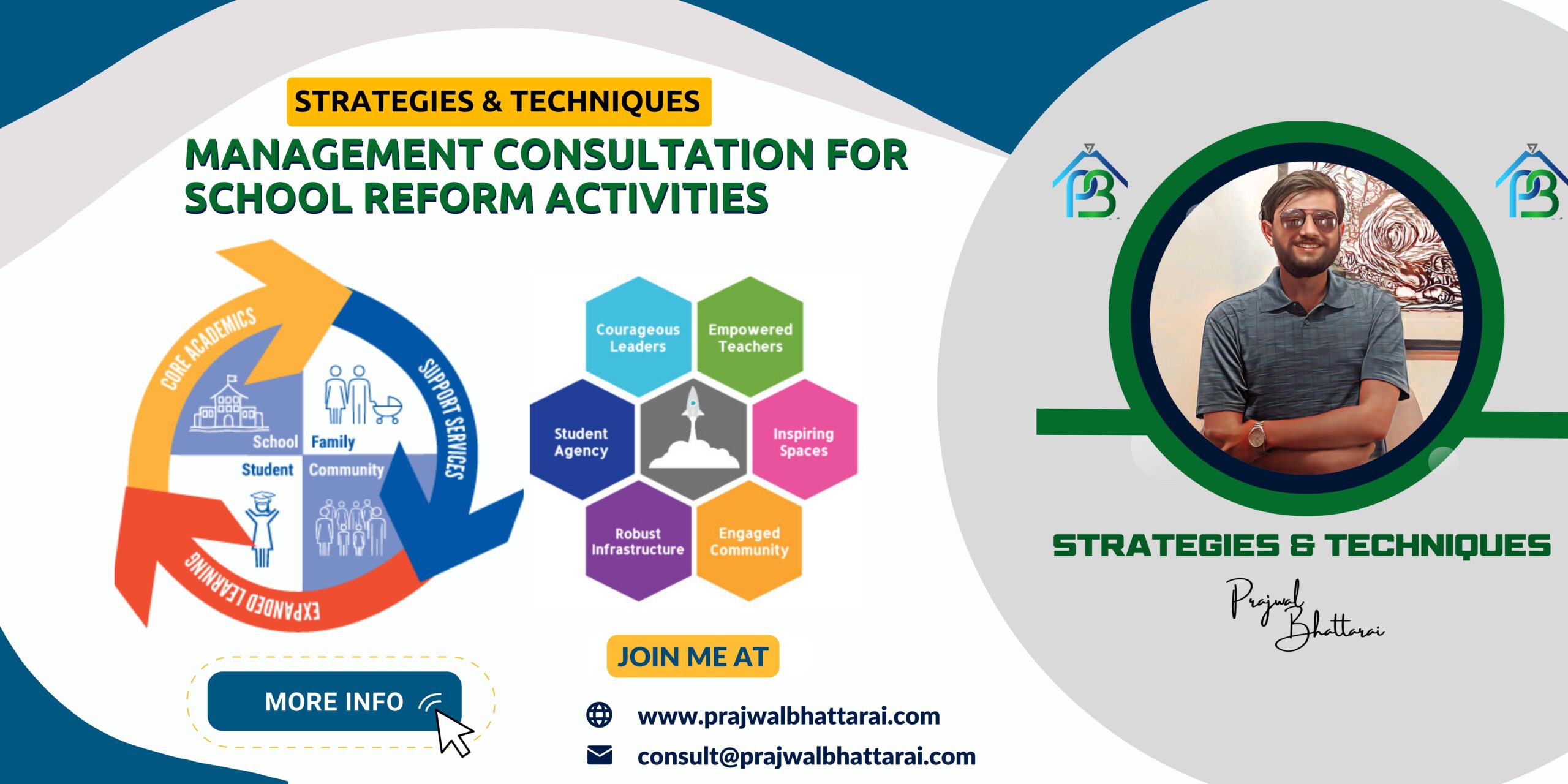Strategies and techniques for each of the areas where management consultation can reform school management and student outcomes, society, parents, results, and school reputation and administration:
-
Clear objectives and goals
-
Examples: Setting a goal to improve student achievement in a specific subject, or increasing the use of technology in the classroom.
-
Techniques: Developing a strategic plan, establishing a mission statement and objectives, and regularly reviewing progress towards goals.
-
Improved communication
-
Examples: Regular staff meetings, parent-teacher conferences, or using online platforms to share information.
-
Techniques: Providing training on effective communication, establishing communication protocols, and regularly soliciting feedback from staff, parents, and students.
-
Enhanced processes
-
Examples: Streamlining administrative processes, implementing new teaching methodologies, or providing targeted professional development for staff.
-
Techniques: Conducting regular process audits, using data to inform decision-making, and regularly reviewing and updating policies and procedures.
-
Increased accountability
-
Examples: Regular progress reports, tracking student achievement data, or implementing a system for recognizing and rewarding staff and students who demonstrate exceptional performance.
-
Techniques: Establishing clear roles and responsibilities, creating performance metrics and indicators, and regularly reviewing and analyzing data.
-
Continuous improvement
-
Examples: Ongoing professional development for staff, engaging in regular self-assessments, or seeking external accreditation.
-
Techniques: Providing regular feedback and coaching, establishing a culture of continuous improvement, and regularly reviewing and revising goals and objectives.
-
Society and Parents
-
Examples: Regular communication, offering volunteer opportunities, or hosting parent information nights.
-
Techniques: Creating parent and community advisory groups, partnering with local businesses and organizations, and promoting school activities and events in the community.
-
Results and School Reputation
-
Examples: Promoting student achievements, showcasing the school’s successes through social media and other platforms, or seeking external recognition through accreditation or awards.
-
Techniques: Using data to track and analyze student achievement, developing marketing and branding materials, and establishing partnerships with universities and other educational institutions.
-
Administration
-
Examples: Providing training for administrators on QMS processes and techniques, establishing a QMS team to oversee implementation, or creating a system for regular data reporting and analysis.
-
Techniques: Establishing a clear chain of command and decision-making authority, providing regular training and professional development, and using data to monitor and evaluate performance.
Prajwal Bhattarai is extensively involved in academic activism, specifically in the reformation of educational institutions. He has implemented various techniques aimed at achieving this goal. By focusing on clear objectives and goals, improving communication and processes, increasing accountability, promoting continuous improvement, and engaging with society and parents, schools can achieve the benefits and provide a high-quality education to their students.
-
Implementing Differentiated Instruction: Differentiated instruction involves tailoring teaching methods and materials to meet the individual needs of students, based on their learning style, interests, and abilities. Teachers can use a variety of techniques, such as project-based learning, small group instruction, and individualized learning plans, to differentiate instruction. Documentation ideas can include examples of differentiated instruction, student assessments, and teacher feedback.
-
Enhancing Parent and Family Engagement: Encouraging parent and family involvement in their child’s education can improve student outcomes and create a positive school culture. Schools can implement strategies such as parent-teacher conferences, family engagement nights, and parent education programs to improve engagement. Documentation ideas can include attendance records for family events, feedback surveys from parents, and testimonials from families who have been involved in the school community.
-
Redesigning Classroom Spaces: Classroom design can impact student engagement, behavior, and learning outcomes. Schools can redesign classroom spaces to support collaborative learning, technology integration, and flexible seating arrangements. Documentation ideas can include photographs and floor plans of redesigned classroom spaces, teacher feedback, and student achievement data.
-
Implementing Restorative Justice Practices: Restorative justice practices involve resolving conflicts and addressing harm through dialogue, mediation, and community-building rather than punishment. Schools can implement restorative justice practices to promote a positive school culture and reduce discipline problems. Documentation ideas can include a summary of restorative justice practices, disciplinary data before and after implementation, and testimonials from teachers, students, and families.
-
Developing Career and College Readiness Programs: Schools can develop career and college readiness programs to prepare students for post-secondary education and future careers. These programs can include college preparation courses, career exploration opportunities, and internships or apprenticeships. Documentation ideas can include student enrollment data, testimonials from students who have completed the programs, and partnerships with local businesses and post-secondary institutions.
-
Improving School Nutrition: Nutrition plays a critical role in student health and academic achievement. Schools can improve school nutrition by offering healthy meal options, promoting nutrition education, and incorporating physical activity into the school day. Documentation ideas can include a summary of the school nutrition program, participation rates for school meals, and data on student health and academic outcomes.
-
Enhancing Language and Cultural Proficiency: Creating a culturally responsive school environment can improve student engagement and academic outcomes. Schools can enhance language and cultural proficiency by providing professional development for teachers and staff, implementing culturally responsive curricula, and promoting diversity and inclusion. Documentation ideas can include a summary of professional development programs, student achievement data, and testimonials from students and families.

